
9 minute read
Sweet Mountaintop fl owers delight
MADE IN CARPINTERIA
Advertisement
BRENDA TAN
Mary Gonzales is well-known by many weekly shoppers at the area farmers’ markets. Off ering a refreshing variety of fi eld-grown fl owers and medicinal herbs, this farmer has found a niche with her home-grown business, Sweet Mountaintop Farm.
Sweet Mountaintop Farm grows their two-acres of herbs and everlasting fl owers in-between the avocado orchards of Rincon Mountain. Gonzales grows herbs for medicinal healing in several forms—from fresh herb bundles to dried herb varieties and blends. Gonzales also makes hydrosols, essential oils and tinctures, fresh plant matter infused in organic alcohol that is potent and used for aromatherapy.
“Some products are for external use, some for internal use,” said Gonzales. “Some people prefer to take medicine through the skin using herb infused body oils. Others who prefer not to drink tea may want to try a tincture. We have diff erent ways to prepare medicine to be accessible to all sorts of people.”
Sweet Mountaintop also makes garlands with strawfl owers, known as a type of everlasting fl ower that dries well. The everlasting fl owers are fashioned into various products such as wreaths, jewelry and fl ower crowns.
Gonzales’ interest in herbs was something she came to intrinsically, she noted. “There are signs everywhere that draw you in. You dream about it and wonder why you are so interested. Maybe you’re drawn in because it’s your life path. Maybe that’s why I’m here and that is my purpose.”
Before starting her own farm, Gonzales used to be a baker in Los Angeles. Along with a couple friends, she traveled around to meet people in funky spaces and diff erent living situations. After moving back to Carpinteria, Gonzales co-authored “A Tiny Mess,” with Maddie and Trevor Gordon. “A Tiny Mess” features recipes and stories from people cooking in their small kitchens in boats and trailers. “I was living in a little 22-foot travel trailer, and then I moved back to this area to live on a trailer on my dad’s farm,” she recalled. “Growing up, I always helped out at the farm for my dad. We worked out a deal where I exchanged work for rent so I learned how to do irrigation for the farm and to prune the avocado trees. I had a plot for my own garden and I just became addicted and fell in love. It’s hard not to be so in love with it.”
On being a farmer and owning her own business she remarked, “it means relying on all the elements, it means time investment and money investment and gambling with the seasons and the
Author and farmer Mary Gonzales makes fl ower wreathes at Sweet Mountaintop Farms.
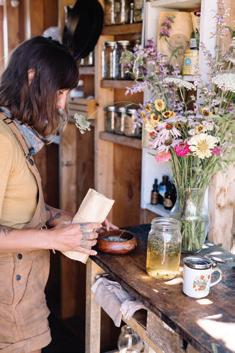
weather. It’s 24/7 never-ending work. You don’t get time off . You have to take care of your animals; the plants need to be watered; there are plants to be harvested. Then you need to fi gure out where to sell all your stuff … It’s something no one can explain to you and you can’t understand until you own your own business and experience it for yourself. So, we rented a couple acres off my dad’s property and we took off from there.”
Gonzales now seeks to provide the same learning experience for others. Sweet Mountaintop now has an internship program where they teach women how to farm and grow medicine. “I want to give women a chance to learn how to farm,” she said. “You have a lot of women up here and everyone is excited and there’s so much energy. It makes me excited to work. The farming market feels like such a masculine environment, and it’s hard for women to get jobs as farmers. I think times are changing. People are realizing it’s important to shift the energy. Decades ago, females were the farmers. We were the keepers of life and it’s an
Gonzales grows a variety of fl owers on her two acres of farmland. Additionally, she cultivates fresh herbs for essential oils and tinctures.
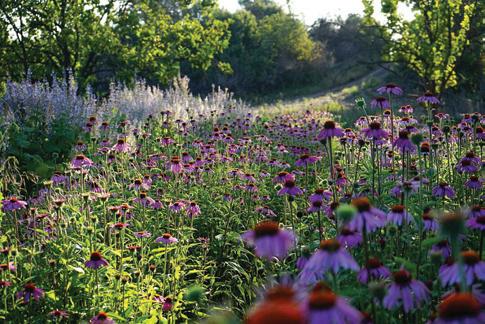
important role to maintain.”
Gonzales has accumulated her repertoire of herbal knowledge through self-taught learning. She commented, “I’ve learned so much from books. I also believe in following intuition, your inner knowing, ancestral remembrance and being with the plants. You can’t learn much unless you are around the plants. I get knowledge from the plants just by having a daily ritual around them and growing plants on a larger scale. Your plants are your biggest teachers.”
For Gonzales, it’s important to understand that herbal medicines require time and consistency, but they can provide many benefits to whole body health. “People want instant results and it’s hard for them to remember that,” she said. “There are herbs that are stress relieving, herbs that will help you adapt to stress, to help you sleep, to not get sick, to help your respiratory system… We grow a lot of varieties used for multiple purposes. Unlike individual prescriptions, one herb has so many medicinal properties. People are used to taking one prescription for each symptom, but with herbs, each plant has a wide range of benefi ts.”
Gonzales recommends starting with one herb at a time to feel it out individually. “It’s important to know what you’re working with,” she said. “You have to create that relationship. It’s like being in a new relationship where you have to get to know somebody and spend time with them.”
To learn more, visit sweetmountaintop. com.
Brenda Tan is a columnist and a freelance writer. She is currently pursuing a bachelor’s degree in English, Writing and Literature, and Art History with an emphasis in Museum Studies at UCSB. She can be reached at brendatan321@gmail.com.
MEDICARE ANNUAL ELECTION PERIOD

Concerned? We Can Help!


Day tripping in Port San Luis
UNPREDICTABLE WILDERNESS
CHUCK GRAHAM
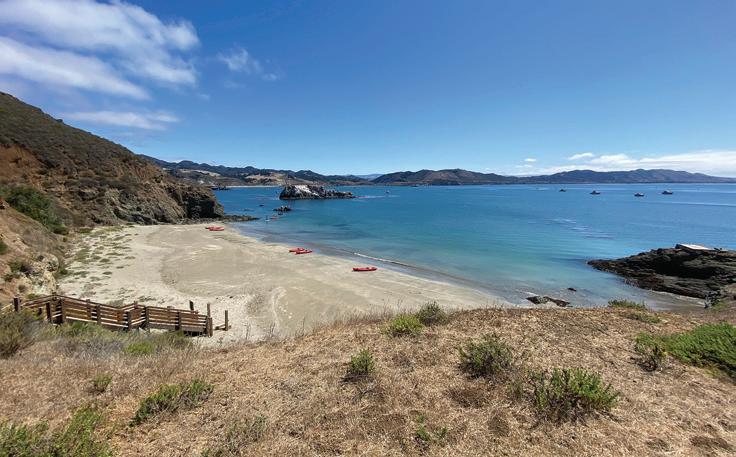
The launch off the secluded beach was nearly effortless, nary a ripple lapped on the sand in northern Avila at Port San Luis Harbor. Protected by a long rocky jetty extending out to the south, the calm waters were a safe haven for several species of marine mammals best observed from the seat of a kayak.
Wildlife Watching
As Holly Lohuis and I paddled our kayaks off the shoreline and through a maze of anchored boats, a raft of southern sea otters wrapped up in a dense canopy of giant bladder kelp, fastidiously grooming their dense fur, the thickest in the entire animal kingdom. Their pups, adorned in light brown fluff, rested on their mother’s bellies, as they too were groomed by their attentive moms—all the while nursing above chilly waters.
As we floated in our kayaks and marveled at this keystone species, the pull of nearby bellowing California sea lions was too much to resist to the immediate north. Piled atop a floating dock, the eared pinnipeds hauled out, soaking in the morning sun as we glided by and eventually beneath the Harford Pier.
Holly and I aimed for guano-covered Smith Rock. Another small raft of otters enjoyed the lee of the broad rock face, sharing it with several sleepy surf scoters, seabirds that migrate down from Alaska. Squadrons of California brown pelicans roosted above on its craggy crest. Below them was a pair of black oystercatchers standing watch over their two fuzzy black chicks. They momentarily revealed themselves before vanishing underneath the security of their mother’s wings. It was a busy day on and around Smith Rock.

Whales Cove
Beyond crowded Smith Rock was Whales Cove and the long jetty that stretched over a half mile into open ocean. The jetty was loaded with barking sea lions. A couple of solitary sea otters lazed in the shallows off Whales Cove, a perfect place to land kayaks and standup paddleboards, walk the beach and have lunch.
It was also a nice pit stop to continue north on foot. At the top of the wooden staircase was a scenic overlook of Port San Luis. We enjoyed stellar views that extended from Avila Beach all the way south to the Guadalupe – Nipomo Sand Dunes National Wildlife Refuge and rugged Point Sal.
Graham catches a view of Whales Cove looking back toward Harford Pier and Avila beyond.
Holly Lohuis paddles toward Smith Rock.
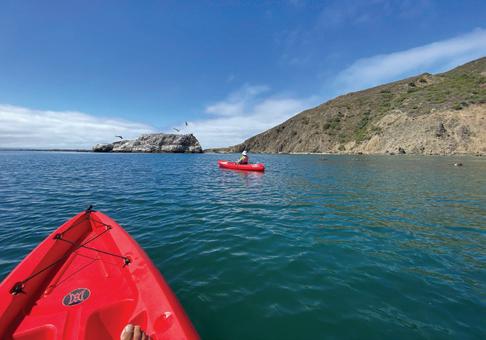
From there, Holly and I made the easy stroll up the paved road leading to the historic Point San Luis Lighthouse, a nice diversion in between our out-and-back day trip of kayaking. Construction of the lighthouse finished in June 1890, following several significant shipwrecks. We learned that the lighthouse was unique in that it is the only surviving Prairie Victorian lighthouse remaining in existence on the entire West Coast of the U.S.
Interpretive areas revealed the history of the region dating back to Chumash Indians who once thrived in the area and eventually leading up to the current restoration efforts. We were free to explore the grounds of the lighthouse, but access inside the light station required a docent.
It was another fantastic place to have lunch, swing on a swing and listen to the surf crash on the wave-battered bluffs below.
Back on the Water
As we returned to Whales Cove, perpetual northwest winds had increased. The convenient tailwind allowed us to simply glide and float past Smith Rock, as we barely paddled to where we began.
The sea otters were especially active on our return. Where the moms groomed and nursed their mewing pups, there were a few young adults that broke the peace of rafting otters. Rambunctious, somersaulting and jostling, the young otters plowed into napping parents, forcing dispersal from the security of the kelp forest.
Once the otters settled down, they always returned to the canopy, wrapping themselves in the long strands to maintain position, especially in the increasing northwesterly winds.
We steered our kayaks between the
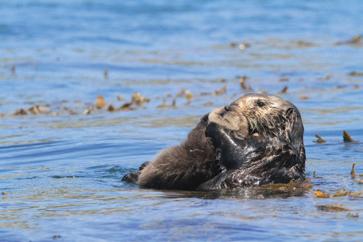
The Point San Luis Lighthouse was constructed in 1890.
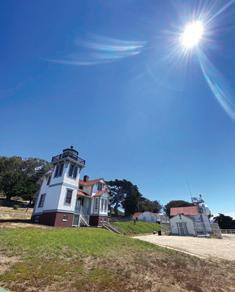
sturdy pilings of Harford Pier, past raucous sea lions before banking left and our launching locale, one of the best kept secrets along the Central California Coast requiring just a short paddle north.
If You Go
If you cannot bring your own kayak (BYOK) or have access to one, you can easily rent one from Avila Beach Paddlesports located at the beginning of the Harford Pier.
Established in 2009 and owned by world class paddler and photographer Vince Shay, Avila Beach Paddlesports was created for a paddling friendly neighborhood environment so visitors could enjoy and learn about the teeming waters of the Central Coast. Rates for kayak and standup paddleboards are $30 for two hours and $40 for a half-day. For more information, go to avilabeachpaddlesports. com, or call (805) 704-6902.
Due to Covid-19, other options to access the lighthouse have been suspended until further notice. Continue to check for the most current updates.
There is a docent-led hike on the Pecho Coast Trail on PG&E property. Call (805) 541-TREK, pge.com.
There are trolley tours operated by Point San Luis Lighthouse Keepers. Call (805) 540-5771 or visit pointsanluislighthouse.org.
Adventure and travel writer Chuck Graham lives in Carpinteria and contributes his writing and photography to publications far and wide. For more wildlife photos, visit chuckgrahamphoto.com or follow Graham on Instagram at @chuckgrahamphoto.

